Content
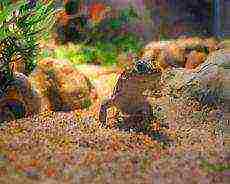
The lizard is a rather exotic pet. If you don't feel like walking your dog in the morning or cleaning the litter box, and the noise from the guinea pig is too much for you, try getting a lizard. The domestic lizard does not make loud noises and does not wake up in the morning, it does not need a lot of space in your room, it has no fur, so it is almost an ideal pet.
How to keep a lizard at home?
Keeping lizards involves providing the animal with a number of specific conditions, but this is very simple and will take very little time. Here are some basic tips on how to care for lizards at home:
- Before you decide to buy and maintain a lizard at home, you should pick and install a terrarium for her... The lizard must have its place in the house, otherwise it will simply run away and may get sick or injured. You can choose a terrarium of any shape, but its height should be at least two body lengths of your pet. The bottom should be covered with earth, but without various fertilizers or additives. Instead of soil, you can use coconut or sand; special rugs are sold in the store. Shavings for rodents or pieces of paper are suitable, you can line the bottom with large pieces of bark.
- In its natural habitat, an ordinary lizard loves various trees, at home it can put some branches in the terrarium... You can decorate your pet's home with various stones, artificial plants, or climbing plates.
- Temperature conditions. Keeping lizards at home assumes the constant presence of two temperature zones in the terrarium. The hot zone should be warmed up to 36 ° C, and the cool one to 30 ° C. The temperature should not drop below 21 ° C at night. You can heat the hot zone with an incandescent lamp or glass-ceramic lamp, you can use an infrared lamp. Heating the soil will be provided by a special mat, which can be purchased at the pet store.
- Lighting. At home, lizards need constant bright lighting. Be sure to install a UV lamp. If you decide to have several pets at once, take care of several heated areas.
- Humidity. A moisture content of at least 50-70% is considered ideal for keeping a lizard. There are several methods to provide such content at home for a lizard. Place a bowl of water in a cool area of the terrarium. The size of the bowl should be chosen taking into account the size of the lizard: it should be easy to climb into it. You can also achieve the required moisture by spraying or using damp sponges. Do not forget to constantly monitor the quality of ventilation, in high humidity fungi can form.
How to feed domestic lizards?
In summer, you can feed your pet three times a day. In winter, two meals a day are sufficient. What can you feed a nimble lizard at home? Offer her various insects: spiders, crickets, mealworms, 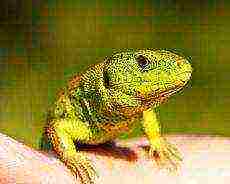 the lizard will not refuse from bird eggs or small mammals. At home, lizards willingly eat a specially prepared mixture: mix finely grated carrots and chopped meat in equal proportions. Add some chopped lettuce and calcium / vitamin supplements.
the lizard will not refuse from bird eggs or small mammals. At home, lizards willingly eat a specially prepared mixture: mix finely grated carrots and chopped meat in equal proportions. Add some chopped lettuce and calcium / vitamin supplements.
You need to feed the lizard during the period of its greatest activity. If you have several pets at once, you need to feed them separately.Be sure to make sure that the lizard eats everything without a trace. When your pet is active and drinks water well, but eats little, there is no reason to worry.
Young animals should be fed with tweezers, while adults can eat on their own from a bowl. Always wash your hands thoroughly after feeding.
The most common type of lizard is the common lizard or, in other words, the nimble lizard. This type of animal is not the most popular for home breeding. If only because they rarely breed in captivity. Of course, there are many advantages to a handheld mini dinosaur: for example, it does not need to be walked, and this animal is much quieter than cats or dogs. Although it still requires some conditions of detention.
 So, you caught the lizard and brought it home. How to understand what sex a given individual is? Usually males are larger and brighter in color, and during the mating season (the month of May) they become completely green. The age of your lizard can be determined by its size: the older, the larger. On average, they reach a length of about 30 cm (with a tail). Life expectancy is about 6 years.
So, you caught the lizard and brought it home. How to understand what sex a given individual is? Usually males are larger and brighter in color, and during the mating season (the month of May) they become completely green. The age of your lizard can be determined by its size: the older, the larger. On average, they reach a length of about 30 cm (with a tail). Life expectancy is about 6 years.
Common lizard at home
Having decided on the sex and age of your captive, you need to create certain conditions for her life so that she does not starve to death in the first week. The animal is small enough, so her requirements are appropriate.
First, you need a long, horizontal enclosure. Of course, she can live for some time in an ordinary three-liter jar, but an ordinary lizard is a rather active creature, she needs to "roam" somewhere. Also, keep your enclosure tall enough to be surprised at how far the lizards can jump. If you don't want her to just jump out of the glass shelter, this condition must be met.
 Secondly, you must create the usual conditions in the terrarium. First of all, this concerns the land where she will dig her burrows. The land should be free of any additives and fertilizers, you can also use sand or shavings for rodents sold at any pet store. Be sure to throw various branches into your lizard's new home, because this species in the wild loves to climb trees.
Secondly, you must create the usual conditions in the terrarium. First of all, this concerns the land where she will dig her burrows. The land should be free of any additives and fertilizers, you can also use sand or shavings for rodents sold at any pet store. Be sure to throw various branches into your lizard's new home, because this species in the wild loves to climb trees.
Required temperature, lighting and humidity
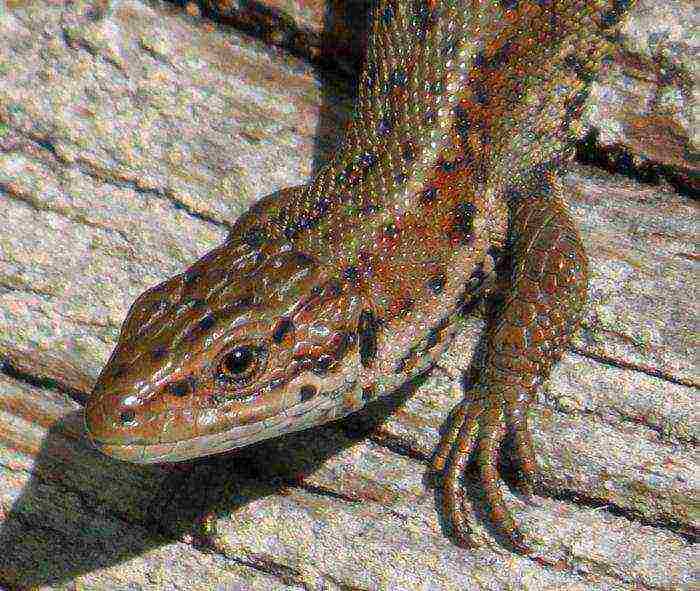 The common lizard requires a lot of heat in order to warm up and not fall into suspended animation. The total temperature of the enclosure should not be lower than 21 ° C at night and 30 ° C during the day. But you definitely need a zone where it will be 36 ° C during the day, so that your pet can receive the warmth it needs. This can be achieved with various lamps, such as infrared or glass ceramic. With the same lamp, you can give your lizard the necessary light. The soil should also be warmed up with a special mat, which you can find at the pet store. For the necessary humidity in the terrarium in the coolest place, you need to put a bowl of water in which your lizard would fit completely.
The common lizard requires a lot of heat in order to warm up and not fall into suspended animation. The total temperature of the enclosure should not be lower than 21 ° C at night and 30 ° C during the day. But you definitely need a zone where it will be 36 ° C during the day, so that your pet can receive the warmth it needs. This can be achieved with various lamps, such as infrared or glass ceramic. With the same lamp, you can give your lizard the necessary light. The soil should also be warmed up with a special mat, which you can find at the pet store. For the necessary humidity in the terrarium in the coolest place, you need to put a bowl of water in which your lizard would fit completely.
What do common lizards eat?
It is understood that these are insects: spiders, earthworms, crickets, grasshoppers. Boiled chicken eggs are very nutritious for the lizard. Young individuals need to be fed with tweezers, otherwise they will simply starve to death. In addition, the lizard is stressed when it falls into captivity, it may refuse to eat. In this case, you need to put food directly into her mouth. Such a lizard should be fed three times a day. In two weeks she will get used to the situation and will eat measured herself.
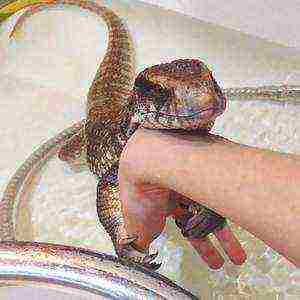 The lizard is a rather exotic pet. If you do not want to walk the dog, clean the cat litter box every day, and the noise from the guinea pig is unacceptable, you can get a reptile.
The lizard is a rather exotic pet. If you do not want to walk the dog, clean the cat litter box every day, and the noise from the guinea pig is unacceptable, you can get a reptile.
She does not make loud sounds, does not wake up in the morning, she does not need to allocate a lot of space in the room. Having stopped your choice on the adjoining one, you need to know how to keep the lizard at home.
General information about lizards
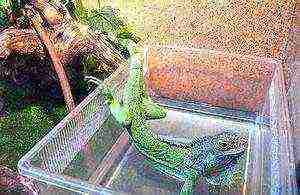 These cold-blooded individuals are predators.There are many types and sizes of lizards that can be kept at home, from large and clumsy to small and nimble.
These cold-blooded individuals are predators.There are many types and sizes of lizards that can be kept at home, from large and clumsy to small and nimble.
Each type is interesting in its own way for both a professional and an amateur and requires an individual approach.
Lizards unpretentious and do not really want to communicate with their owner, which is great for those who prefer to contemplate a pet, and not mess with it.
Depending on the size of the reptile and on its type food can also be quite varied. Some representatives, like snakes, can go without food for a long time.
Lizard in nature
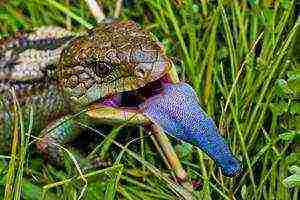 To date, science knows 9 subspecies of lizards. They are distributed over a large territory of Eurasia from Central Siberia to the Atlantic coast.
To date, science knows 9 subspecies of lizards. They are distributed over a large territory of Eurasia from Central Siberia to the Atlantic coast.
Within the borders of Russia area the distribution of these amphibians is quite extensive: from the Caucasus in the south to Karelia, the Leningrad and Arkhangelsk regions in the north, from Baikal in the east to the borders with Belarus.
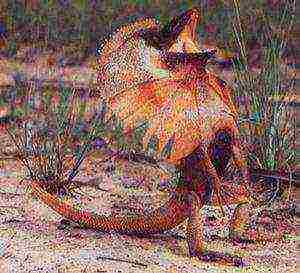 Nimble lizards vary in size. Depending on the subspecies, the length of the animal can be from 5 cm to 25 cm. Females are slightly smaller than males. In males, the color is bright greenish-yellow, in females, the abdomen is white or yellowish.
Nimble lizards vary in size. Depending on the subspecies, the length of the animal can be from 5 cm to 25 cm. Females are slightly smaller than males. In males, the color is bright greenish-yellow, in females, the abdomen is white or yellowish.
Respectively biotope the natural existence of lizards is different. These are mixed and coniferous forests, wet wetlands, steppes and forest-steppes, dry rocky areas. These reptiles are leading predominantly terrestrial day life, but can climb rocky slopes and trees.
 Lizards do not go far from the inhabited territory, digging narrow burrows in the ground. During the hunt, reptiles do not move more than 15 meters from their burrow, so that in case of danger they can hide in a shelter.
Lizards do not go far from the inhabited territory, digging narrow burrows in the ground. During the hunt, reptiles do not move more than 15 meters from their burrow, so that in case of danger they can hide in a shelter.
Common lizards feed on invertebrates: worms, snails, insects, often eating neighbors and their own young.
Housing selection
 Cell selection directly depends on the type of lizard. There should be enough space in the terrarium to move it freely. Reptiles need a certain temperature.
Cell selection directly depends on the type of lizard. There should be enough space in the terrarium to move it freely. Reptiles need a certain temperature.
If the temperature in the apartment falls below a certain value in winter, a heated terrarium will be needed. Cage temperature, lighting and air humidity must be controlled. When choosing a home, you must adhere to certain rules and know how to care for a lizard:
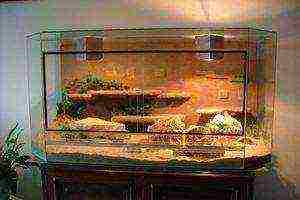 the cage must be securely locked so that the reptile does not get out of it;
the cage must be securely locked so that the reptile does not get out of it;- small geckos fit an aquarium, covered with a screen on top; for leopard geckos - 75 liter terrarium;
- for small reptiles, such as a bearded agama, a plastic container will work. But the best option for them would be a vivarium made of insulating material with a volume of 200 liters. An example of such a dwelling would be a wooden aquarium with a glass front wall. When choosing a plastic container, you must take into account that it must be at least 0.6 meters in height and 0.6 × 1.2 m at the base.
- another option is a wire cage, which is most suitable for chameleons. It should be high enough to crawl up the walls.
Filling the aquarium
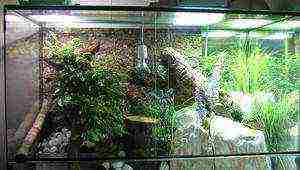 The filling of the aquarium has a large meaning... This can be a composition of branches, potted plants and pebbles. All components must be natural so that the animal does not develop skin disease or allergies. The branches installed in the terrarium must support the weight of the pet so that it does not get hurt by breaking them off.
The filling of the aquarium has a large meaning... This can be a composition of branches, potted plants and pebbles. All components must be natural so that the animal does not develop skin disease or allergies. The branches installed in the terrarium must support the weight of the pet so that it does not get hurt by breaking them off.
It is undesirable to use stones as soil. Better to give preference special substrates, paper, pieces of bark, coconut flakes. The ideal terrarium selection will take some time to follow the lizard. Noticing that the scaly eats the soil, the base must be changed. It is categorically impossible to use "bedding" as a soil for feline toilet or their analogs.
The reason for careful selection of bedding for the terrarium is that if swallowed, pieces of soil can get up in the intestinal tract, provoking disease and even death of the lizard.
The microclimate required for a lizard
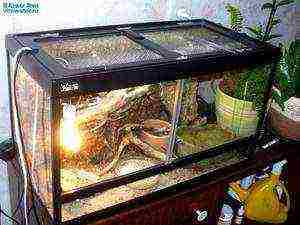 To maintain the correct temperature in the cage, many reptiles require infrared lamp. When choosing it, you need to know that different lamps emit different amounts of heat. In order for the lizard to feel comfortable in the terrarium, it is necessary to adhere to certain rules:
To maintain the correct temperature in the cage, many reptiles require infrared lamp. When choosing it, you need to know that different lamps emit different amounts of heat. In order for the lizard to feel comfortable in the terrarium, it is necessary to adhere to certain rules:
- find the most suitable temperature for your pet by asking the pet store how much heat it needs. Most reptiles require an area with a temperature of 32-38 ° C;
- the reptile also needs a cool area, so the lamp should be placed in the corner of the cage. In a cool area, as a rule, the temperature should be 21-24 ° C;
- the temperature in the cage should be checked regularly, taking into account that it should be different in different parts of the cage;
- turn off the heating lamps at night, replacing them with a ceramic heater.
Lighting
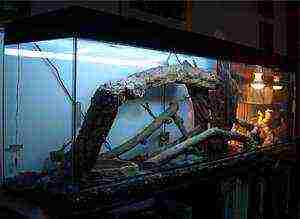 As already noted, for the normal maintenance of scaly at home, ultraviolet lamps of the long-wave and medium-wave range will be needed. They are turned on for about 12 hours.
As already noted, for the normal maintenance of scaly at home, ultraviolet lamps of the long-wave and medium-wave range will be needed. They are turned on for about 12 hours.
Reptiles need an area where they can bask and bask in the light. Therefore, you should prepare a lamp flooding Sveta. To add a spectrum of illumination, UV light is added to the fluorescent lamp.
The lamp is fixed inside the cage so that the lizard can get to it and bask in its rays, but not get burned at the same time.
Most of the cage should be in the shade.
Feeding the lizards
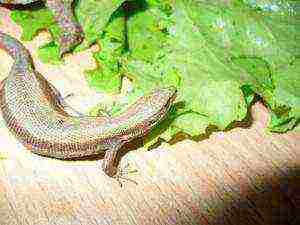 Lizards feed plant and animal food. The basis of their food is insects: earthworms, spiders, grasshoppers, crickets. Boiled chicken eggs are very nutritious for reptiles. You can diversify pet food by mixing chopped cabbage and carrots with pieces of meat.
Lizards feed plant and animal food. The basis of their food is insects: earthworms, spiders, grasshoppers, crickets. Boiled chicken eggs are very nutritious for reptiles. You can diversify pet food by mixing chopped cabbage and carrots with pieces of meat.
Lizards are rarely fed, but they can eat a considerable amount of food at one time. Juveniles are fed with tweezers.
 Once in captivity, reptiles can refuse food, so they should put food straight in the mouth. After two weeks, they get used to the situation and begin to feed themselves.
Once in captivity, reptiles can refuse food, so they should put food straight in the mouth. After two weeks, they get used to the situation and begin to feed themselves.
Any pet should be shown to the veterinarian at least once a year. Noticing painful formations on the skin, they should be eliminated in time so that the lizard does not die.
 It is important not to forget that these are warlike creatures. They often compete with each other and can even attack a person. Noticing that one of the individuals is being oppressed, it is worth resettle or give it to friends. Otherwise, relatives can simply persecute such a lizard.
It is important not to forget that these are warlike creatures. They often compete with each other and can even attack a person. Noticing that one of the individuals is being oppressed, it is worth resettle or give it to friends. Otherwise, relatives can simply persecute such a lizard.
Large representatives of this species, without receiving adequate feeding and care, can covet on fingers household members. Therefore, you should not keep large reptiles in a house with small children.
> > > > >
When you need to equip a living corner in an apartment, and there is not so much free time for keeping an animal, then you can get an ordinary lizard. She is unpretentious, does not make noise, does not require regular walks in the fresh air, for her life in captivity she does not need a large terrarium. Pretty much the perfect pet, isn't it?
A quick (common) lizard in nature
This living creature is considered exotic at home. That is why, so that no problems arise during maintenance, it is necessary to know its natural living conditions.
Anyone who walked through the forest met these green or brown lizards, nimbly hiding in the grass or bushes at the slightest danger. These are representatives of the species Lacerta agilis Linnaeus (lat.) Or nimble lizards.
Currently, science knows 9 subspecies, which are distributed over the vast territory of Eurasia from the Atlantic coast to Central Siberia.
Within Russia, the distribution area of these amphibians is very large: from Karelia, the Arkhangelsk and Leningrad regions in the north to the Caucasus in the south and from the border with Belarus in the west to Baikal in the east.
Accordingly, the biotope of natural existence is different: damp wetlands, coniferous and mixed forests, forest-steppe and steppe, stony dry areas of the territory. She leads mainly daytime terrestrial life, but can climb high both on trees and on stone slopes.
Nimble (or ordinary) lizards do not go far from their inhabited territory, sometimes digging narrow burrows in the ground.
During the hunt, these reptiles do not move more than 15–20 meters from their burrow, so that in case of danger there is an opportunity to quickly hide in their shelter.
The size of the nimble lizard can also be different. The length of an animal with a tail varies from 5 to 25 cm (depending on the subspecies). Males are usually slightly larger than females, their color is usually brighter. The abdomen of males is greenish-yellow, while that of females is white or slightly yellowish.
Common lizards feed on a variety of invertebrates: snails, worms, insects. They can eat both their own and the “neighbor's” young growth.
If the animal is abruptly grabbed by the tail, then it can try to bite, and when it breaks free, it can leave its tail to the “enemy”. In this case, there will be no bleeding, since the muscles of the animal in the area of the tilted tail are almost instantly contracted. After some time, the caudal process is restored (regenerated), but, as a rule, the new tail is somewhat shorter than the "old" one. This feature of the body should be taken into account when kept at home.
Terrarium organization
Keep an exotic pet only in a terrarium. A lizard roaming freely around the house can get injured or burned.
The size and shape of the terrarium can be any, but there is an unwritten rule: the height of the walls of an artificial dwelling should be equal to the length of the amphibian multiplied by 2. At least. Let's remind: lizards can easily climb even on a vertical wall.
The material for the terrarium can be ordinary glass (an old aquarium will do just fine), but the lifting lid is better made of wire mesh. In addition, small ventilation holes must be arranged in the side walls.
There are variants of a "house" made from an old bookshelf. In this case, one side wall and the cover of the makeshift terrarium are also made of wire mesh.
It is recommended to cover the bottom with soil; coarse-grained sand, pebbles and even ordinary earth are perfect for this.
For your nimble pet, it would be nice to decorate the landscape with branches or stumps of trees, snags, stone slides, and caves. A nimble lizard will definitely like this decor.
Microclimate
The animal feels fine at room temperature, but if a representative of one of the southern subspecies lives in the terrarium, then the temperature should be maintained within the range from +25 to +30 degrees during the day and from +18 to +20 degrees at night.
The temperature regime can be provided either with a thermal mat or with an ordinary incandescent lamp with a reflector. But in this case, the lamp should be located out of the reach of the animal.
Humidity should be maintained at least 75–80%, which is achieved by regularly spraying the inside of the terrarium.
To organize food, you need to install a food cup and drinker. Over time, the lizard gets used to one place to eat and drink.
Common lizard: what to feed
There is an opinion that this nimble amphibian can be given pieces of "human" food, the remains of a family meal. In principle, this is so, but this feed should not be abused in any case.
You should still provide a diet that is close to natural.
- That is why spiders, cockroaches, grasshoppers, worms (even flour worms) are normal food for lizards.
- You can prepare a nutritional mix consisting of grated carrots and chunks of meat (minced meat is allowed).
- And if you add finely chopped spinach or dandelion leaves to such a mixture, then the lizard will receive not only protein, but also vitamins necessary for normal development.
Feeding should be done in the daytime 3 times. In winter, during a period of decreased activity, you can switch to two meals a day.
Summing up
As you can see, keeping a jumping lizard in a house or apartment is quite simple. If you closely monitor the well-being and behavior of the agile green minx, establish a firm feeding schedule, observe a normal temperature and humidity regime, and maintain cleanliness in the terrarium, then a smart lizard will get used to its owners. And then she will not be afraid of human hands.
Video on how to keep an ordinary lizard at home:


